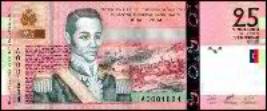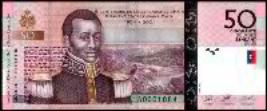 General Nicolas Geffrard appears on the front of a new 25 Gourdes design with the Fortress of the Platons in Dussis (Les Cayes) on the back. This is the first appearance for General Geffrard on a Haďti banknote, although his son Fabre-Nicolas was the first figure to appear on a Haďti banknote -the 1827 issues of 1 and 2 Gourdes (#41 and #42). Geffrard was born in 1862, became an aide-de-camp to André Rigaud, who later became
President of the Council of the South Haďti. On 15.5.1800 during battles for control of the country by various factions, Rigaud and Geffrard were driven into the hills by Dessalines and Christophe and by 7.29.1800 the South was lost to Touissant. Geffrard
fled on board the corvette Vertu and later returned to South Haiti becoming the Governor . He was one of the key leaders of the revolution achieving the rank of Major General, a level accorded to only five others. General Nicolas Geffrard was one of the signatories of the Act of Independence at Gonaďves on 1.1.1804. He died in 1806. General Nicolas Geffrard appears on the front of a new 25 Gourdes design with the Fortress of the Platons in Dussis (Les Cayes) on the back. This is the first appearance for General Geffrard on a Haďti banknote, although his son Fabre-Nicolas was the first figure to appear on a Haďti banknote -the 1827 issues of 1 and 2 Gourdes (#41 and #42). Geffrard was born in 1862, became an aide-de-camp to André Rigaud, who later became
President of the Council of the South Haďti. On 15.5.1800 during battles for control of the country by various factions, Rigaud and Geffrard were driven into the hills by Dessalines and Christophe and by 7.29.1800 the South was lost to Touissant. Geffrard
fled on board the corvette Vertu and later returned to South Haiti becoming the Governor . He was one of the key leaders of the revolution achieving the rank of Major General, a level accorded to only five others. General Nicolas Geffrard was one of the signatories of the Act of Independence at Gonaďves on 1.1.1804. He died in 1806.
His son Fabre-Nicolas Geffrard was born in Anse-ŕ-Veau, Haďti on 19.9.1806 and served as President from 18.1.1859 until he was ousted on 13.3.1867. In 1863, in concert with Abraham Lincoln, he authorized an American entrepreneur, Bernard Kock, to lease Isle A’Vache (Cow Island) to start a colony of freed back slaves from America. During this period Kock issued a series of interesting civil war style banknotes which are rarely
seen. The venture failed and Lincoln sent a ship to retrieve the remaining slaves to return them to America abandoning any further colonization plans.
 The 50 Gourdes front pictures General François Cappoix, (Cappoix-la-Mort) who has never been honored on a banknote, although his image first appeared on Haďtian postage stamps in 1946. Considered the bravest man in the Army, on 18.11.1803
Cappoix-la-Mort
won the decisive battle of Vertičres, defeating Donatien Rochambeau, who succeeded LeClerc after his death from yellow fever. During the battle, Cappoix's horse was shot from under him, "he picked himself up, drew his sword and advanced on foot." Rochambeau capitulated and "presented his favorite stallion to Dessalines and another horse to Cappoix-la-Mort to replace the one the French had killed." The war ended with a great imbalance: 350,000 Haďtians dead, 150,000 French succumbed (of
which 20,000 were Haďtian Creoles who fought for the French.) The 50 Gourdes front pictures General François Cappoix, (Cappoix-la-Mort) who has never been honored on a banknote, although his image first appeared on Haďtian postage stamps in 1946. Considered the bravest man in the Army, on 18.11.1803
Cappoix-la-Mort
won the decisive battle of Vertičres, defeating Donatien Rochambeau, who succeeded LeClerc after his death from yellow fever. During the battle, Cappoix's horse was shot from under him, "he picked himself up, drew his sword and advanced on foot." Rochambeau capitulated and "presented his favorite stallion to Dessalines and another horse to Cappoix-la-Mort to replace the one the French had killed." The war ended with a great imbalance: 350,000 Haďtians dead, 150,000 French succumbed (of
which 20,000 were Haďtian Creoles who fought for the French.)
The back of the 50 Gourdes depicts Fort La Jalousičre at Marmelade.
<Previous Page | 1 | 2 | 3 | 4 | 5 |
Next Page >
Home |
Catalog Index | Haiti Index | Articles | Links | Contact Us

©
Garry Saint, Esquire 1999-2004 All Rights Reserved |